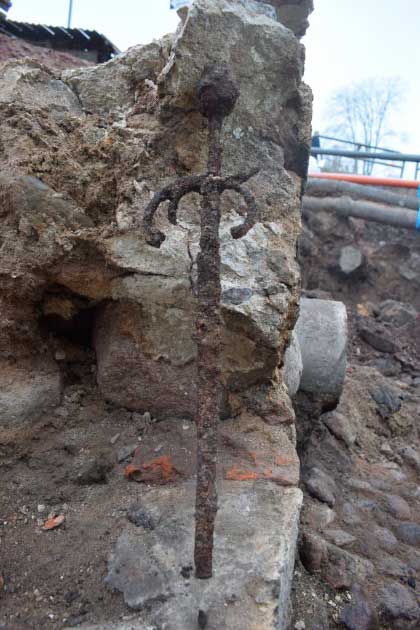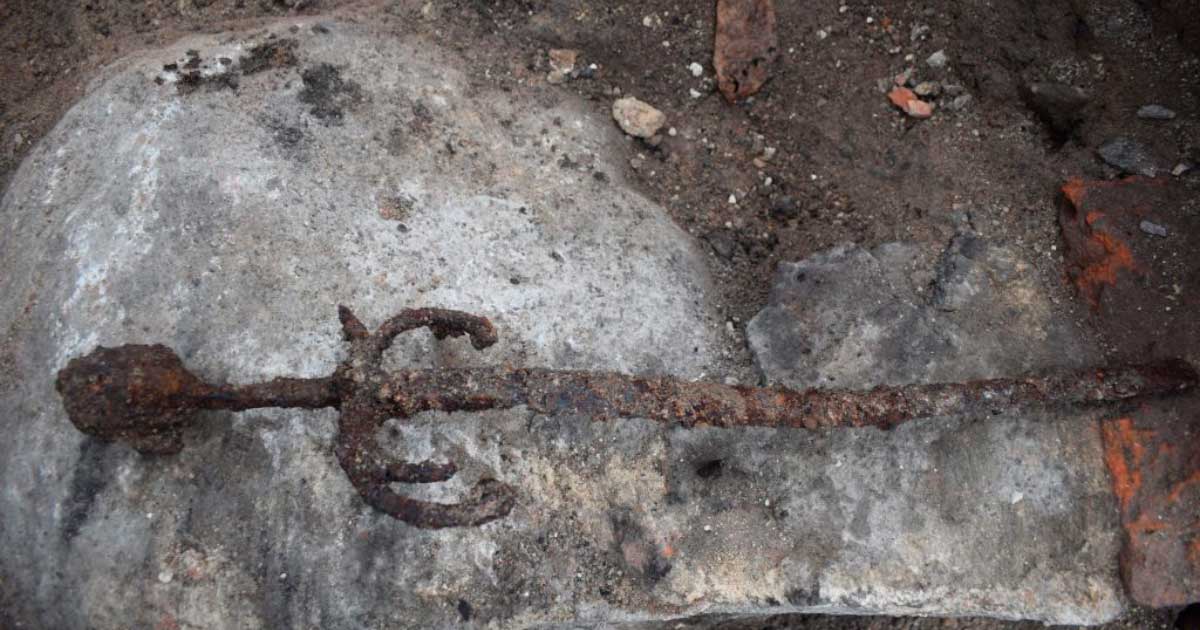Swedish Archaeologists Unearth Rare 17th-Century Battle-Sword: A Milestone in Military Evolution

Discovery and Excavation
The team from Arkeologerna, a prominent Swedish archaeological firm, was conducting a dig at the intersection of Kungsgatan and Västerlnggatan in Kalmar, located on Sweden’s southeastern coast along the Baltic Sea. The area, known for its Renaissance-style Kalmar Castle and well-preserved 17th- and 18th-century buildings, had previously been the site of a medieval farm owned by Gotskalk Hulskede in 1368 AD. The farm was referenced again in a 1483 AD document and was destroyed by fire during the Kalmar War in the summer of 1611 AD.

While excavating the cellar floor, the archaeologists uncovered various artifacts including two severely burned hand grinders, charred grains, and fragments of brick, stone, and wood. These remnants were likely from the upper floors of the buildings that once stood above the cellar. The most notable find, however, was a rare Danish sword buried beneath the collapsed roofing material.
The Kalmar War: Context and Conflict
The Kalmar War (1611-1613 AD) was a significant conflict between Sweden and Denmark-Norway. Tensions began in 1607 AD when King Charles IX of Sweden claimed sovereignty over the traditionally Norwegian Lapp territories and imposed taxes. Sweden’s attempt to bypass tolls imposed by Denmark and Norway by creating a new trade route through Lapland exacerbated the situation.

In response, King Christian IV of Denmark-Norway declared war in April 1611 AD, launching an invasion with 6,000 Danish soldiers. The city of Kalmar and its castle were critical targets due to their control over the Kalmar Strait and access to northern trade routes. Despite initial successes, the Danish forces struggled to decisively defeat the Swedish defenders. After months of siege and heavy casualties—approximately 700 Swedish and 200 Danish soldiers—peace negotiations led to the Treaty of Knäred on January 21, 1613, which ended the war.
Evolutionary Leap in Military Technology

The rare Danish sword found in the cellar is considered a key artifact from the period of the “Military Revolution,” a term coined by historian Michael Roberts in 1955 to describe the transformative changes in warfare from 1560 to 1660 AD. This period saw significant advancements in military tactics and weaponry, contributing to the rise of Western Europe as a dominant global power.
According to Arkeologerna, the discovered sword represents “an evolutionary leap” from earlier medieval designs to the more advanced weaponry that began to define the 17th-century battlefield. This transition reflects the broader shifts in military technology and tactics of the time.
Conclusion
The discovery of the Danish sword in Kalmar not only provides a tangible link to Sweden’s military past but also symbolizes the broader changes in warfare during the early 17th century. As an artifact of the Military Revolution, the sword highlights the advancements in military technology and tactics that emerged from the conflict. This find offers valuable insights into the evolution of weaponry and the historical significance of the Kalmar War, marking an important chapter in Sweden’s military history and its role in shaping modern warfare.
Video
News
The Hanging Temple: China’s 1,500-Year-Old Cliffside Marvel of Faith and Engineering
The Hanging Temple: China’s 1,500-Year-Old Cliffside Marvel of Faith and Engineering Perched precariously on the cliffs of Mount Heng in Shanxi Province, China, the Hanging Temple, also known as Xuankong Temple, Hengshan Hanging Temple, or Hanging Monastery, is an architectural…
The Willendorf Venus: A 30,000-Year-Old Masterpiece Reveals Astonishing Secrets
The Willendorf Venus: A 30,000-Year-Old Masterpiece Reveals Astonishing Secrets The “Willendorf Venus” stands as one of the most revered archaeological treasures from the Upper Paleolithic era. Discovered in 1908 by scientist Johann Veran near Willendorf, Austria, this small yet profound…
Unveiling the Maya: Hallucinogens and Rituals Beneath the Yucatán Ball Courts
Unveiling the Maya: Hallucinogens and Rituals Beneath the Yucatán Ball Courts New archaeological research has uncovered intriguing insights into the ritual practices of the ancient Maya civilization. The focus of this study is a ceremonial offering found beneath the sediment…
Uncovering the Oldest Agricultural Machine: The Threshing Sledge’s Neolithic Origins
Uncovering the Oldest Agricultural Machine: The Threshing Sledge’s Neolithic Origins The history of agricultural innovation is a fascinating journey that spans thousands of years, and one of the earliest known agricultural machines is the threshing sledge. Recently, a groundbreaking study…
Nara’s Ancient Sword: A 1,600-Year-Old Protector Against Evil Spirits
Nara’s Ancient Sword: A 1,600-Year-Old Protector Against Evil Spirits In a remarkable discovery that has captured the attention of archaeologists and historians alike, a 7.5-foot-long iron sword was unearthed from a 1,600-year-old burial mound in Nara, Japan. This oversized weapon,…
The Inflatable Plane, Dropped Behind the Lines for Downed Pilots
Experimental The Inflatable Plane, Dropped Behind the Lines for Downed Pilots The Inflatoplane from Goodyear was an unconventional aircraft developed by the Goodyear Aircraft Company, a branch of the renowned Goodyear Tire and Rubber Company, also famed for the Goodyear…
End of content
No more pages to load











